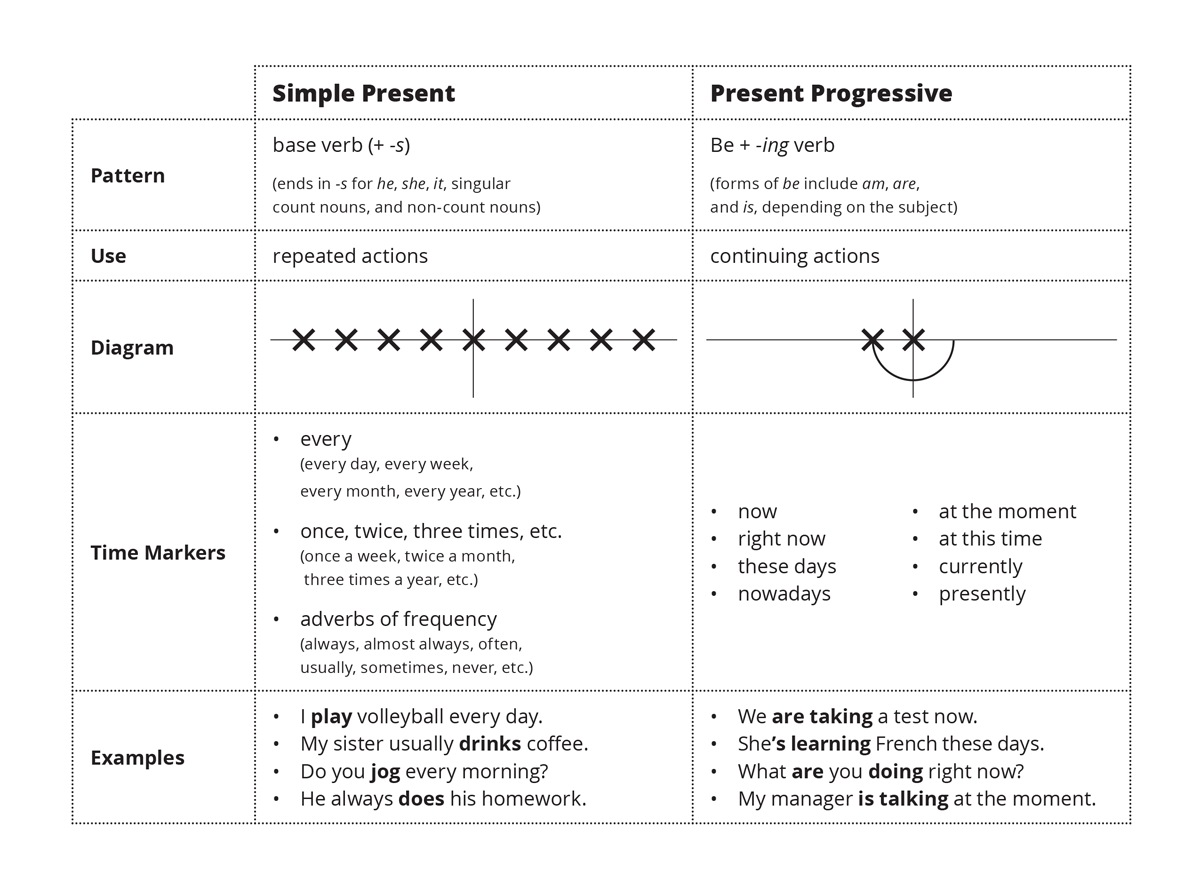Updated February 2017
There are two present verb tenses in English: the simple present and the present progressive (also known as the present continuous). Students sometimes have trouble figuring out when to use each tense, but I’ve found that using a chart such as the one below is a great way to clearly explain the differences between the two tenses.
Simple Present Vs. Present Progressive – Grammar & Usage Resources
Simple Present
Form
Base V (+ -s with third person singular subject)
The simple present looks like the base form of the verb. With a third person singular subject, add the ending -s. Remind students that subjects that need -s include he, she, it, singular count nouns, or non‑count nouns.
Time Markers
A. Repeated Actions
- every (every day, every week, every month, every year, etc.)
- once, twice, three times, etc. (once a week, twice a month, three times a year, etc.)
- adverbs of frequency (always, almost always, often, usually, sometimes, almost never, never, etc.)
B. Non-Action Verbs
- be
- have
- feelings (love, like, hate, etc.)
- thinking verbs (think, know, believe, etc.)
- five senses (see, hear, taste, touch, smell)
Note: There are some exceptions to these rules. For example, some of the verbs above use the present progressive when taking on an “action” role, such as I’m thinking of last night (“remembering”) vs. I think that global warming is a serious problem (“opinion”). Point this out to students, but remind them that these verbs don’t usually use the -ing form.
C. True Facts
- scientific facts
- historical facts
- unchanging truths
- etc.
D. Schedules
- TV schedules
- transportation timetables
- etc.
Examples
- I talk to my best friend every day. (repeated action)
- She never eats meat. (repeated action with adverb of frequency)
- He thinks that you shouldn’t go out tonight. (non-action verb)
- Water boils at 100 degrees Celsius. (true fact)
- Our favourite show starts at 8:00 pm. (schedule)
Present Progressive
Form
Be + -ing V
The present progressive is formed by taking the Be verb and an action verb + -ing. Remind students that forms of the Be verb include am, are, is, and are, depending on the subject.
Time Markers
- now
- right now
- currently
- nowadays
- these days
- at the moment
- at this time
- presently
Examples
- I am studying English nowadays.
- At the moment, Jim is taking a nap.
- He is shopping right now, so he can’t meet up with us.
Non-Action Verbs
Even with the time markers above, non-action verbs almost never take -ing. For example:
- She is happy now.
- She is being happy now.
- My friend has a boyfriend at the moment.
- My friend is having a boyfriend at the moment.
Conclusion
Time Markers provide the best clues for students to figure out what verb tense to use. I always suggest that students memorize the time markers that correspond to certain verb tenses.
Practice
Try our Grammar Practice Worksheets, Grammar Stories, and Basic Grammar Sentences sections for many lessons on the simple present and the present progressive. The Simple Present Vs. Present Progressive lesson has exercises that directly contrast the two verb tenses. We’ve also got a new Simple Present Vs. Present Progressive resource chart and worksheet.



